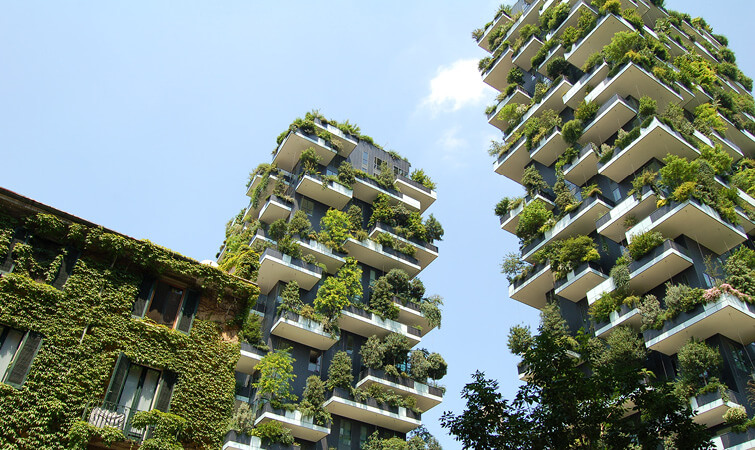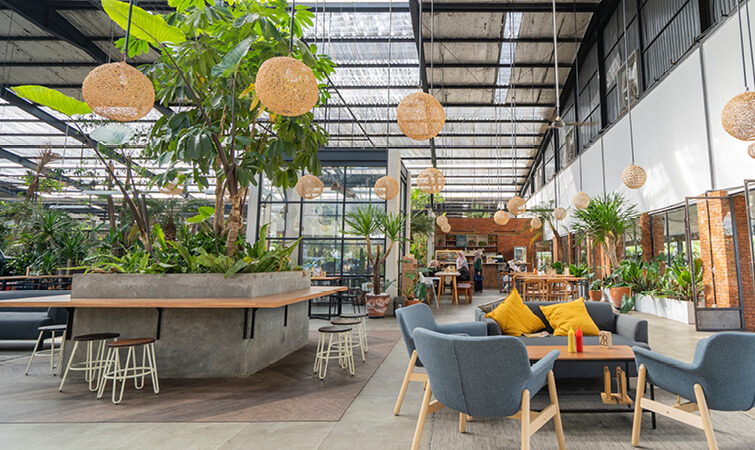
Sustainability as a new standard?
16/12/2019
Sustainability is entering our world more and more. From the conversations we have to the interiors in which we live. With circular materials, air-purifying plants, ingenious technological applications and customised architecture, the interior world is also taking steps towards eco-living. A look at the most remarkable elements of this design vision that increasingly drives hospitality and retail.
Circularity is key
The magic word in sustainable architecture and design is circularity. Products that go beyond the cradle to cradle principle because they are not only recyclable but also reusable. Think of concrete and other rough building material that can be reused in a new building, but also of recycled materials that can be recycled again, such as the decorative UNILIN Evola panels. Made for 95% out of recycled wood, this product claims a worthy place in the circular range.
Small-scale ecosystems
Circularity goes further than just products and buildings. It is also about a closed cycle: hotels that have their own greenhouses on the roof, which are irrigated with their own purified waste water, and the vegetables and herbs from those greenhouses that in turn serve to enhance the menu of the restaurant on the ground floor . In this way, buildings become small islands with their own ecosystem and cities and neighbourhoods are created with a positive effect on their environment and its inhabitants..
Inventiveness and sustainability as a style choice
Nature becomes inescapable: as a driver and as a source of inspiration. Biomimetics, or biomimicry, is a branch of science that focuses entirely on nature’s top hat and studies plants and animals to imitate their construction and processes and apply them to human inventions. For example, there are biomimetic inventions such as green walls that simultaneously serve as insulation and as a heat damper; buildings that have been built with the structure of a honeycomb to generate robustness and yet a lot of light; and solar panels that are built into the awning and, like a complete armour, rotate with the light to optimise energy consumption.
Breathable interior
A less labour-intensive green operation is the installation of large plant walls, both inside and outside, and the use of mineral paints. Plants are known for their air-purifying effect. A sizeable green wall in a hotel lobby or restaurant can largely replace the mechanical air purification. In addition, plants - and their green colours - provide a sense of relaxation. It brings peace to the interior and to the brain. Mineral paints such as lime or loam paint are the ideal moisture regulators. During the day, they absorb the moisture from crowded areas, and in the evening they release it again. In this way, they provide buildings where the moisture balance is always at the right level.
Colruyt and circularity
Outside the hospitality world, attempts are also made to reduce the ecological footprint. Colruyt Group used the old materials from its former buildings for the refurbishment of its shops and offices. All wooden panels and shelves were taken to Unilin Panels and reworked into new panels there. Colruyt Group, for whom is high on its list of priorities, can proudly boats of an interior that consists entirely of circular panels. A mission that Unilin Panels, as a company which is always looking for sustainable optimisation, was happy to contribute to.
More stories:
- From dated furniture to a sleek, brand-new interior: Inntel Hotels goes circular
- UNILIN Panels starts the new year with 7,500 m2 of forest
- Colruyt Group and Unilin Panels complete the circle











